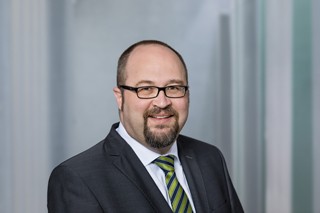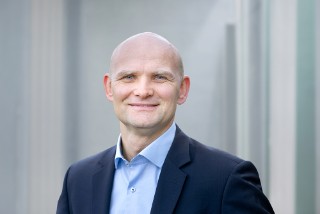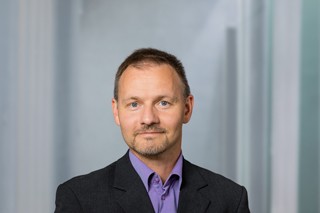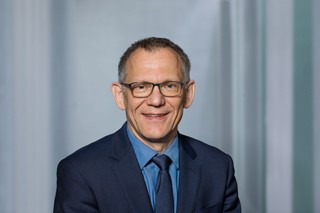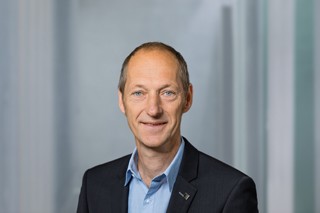Author: Fanny Pohontsch
Carbon in the cycle
Interview with Prof. Martin Gräbner, PD Dr. Matthias Jahn, Dr. Hannes Richter, Dr. Jörg Richter und Prof. Michael Stelter
Carbon (or simply: C) has a bad reputation. At the same time, carbon is everywhere. It is the atom of life and shapes our entire economy. Carbon is part of our DNA, the foods we eat, and the products we use every day. Carbon is part of the fuels that power our vehicles and factories or heat our homes, and the materials we use to build our cities. In industry, carbon is both a source of energy and a raw material – all of organic chemistry and the downstream added value, including the building materials and plastics industries, is based on carbon.
In nature, carbon flows continuously between the atmosphere, the oceans, the vegetation and the earth‘s crust. It was humankind that has knocked the cycle out of balance since the Industrial Revolution by using the fossil, finite sources of carbon oil, gas and coal. When fossil carbon is burned, it reacts with oxygen. This results in carbon dioxide (CO2). In the last 150 years, these emissions from industrial exhaust gases or mobility on land, in the air and at sea have more than doubled the CO2 concentration in the atmosphere – with severe effects on the climate.
The resulting goals, toward which the researchers at Fraunhofer IKTS are also contributing, are diverse: It is important to completely avoid further climate-damaging emissions in order to reduce the human impact on the climate. At the same time, the finite resources of our earth must be protected. In order to meet the demand for carbon for the products and fuels we use in our daily lives in a climate-neutral manner, we need alternative regenerative carbon sources – and process technology with which a sustainable carbon circular economy can be realized, which keeps reusing the carbon that is already in circula-tion (CCU: carbon capture and utilization).
Which sustainable sources of carbon exist?
M. Gräbner: I think that if we want to make carbon available beyond fossil resources as a basis for fuels or for the chemical industry, we have the following options: Firstly, CO2 – the energetically worst form of carbon in terms of energy – can be extracted from the atmosphere via direct air capture only with great effort. It is better to use unavoidable industrial point sources. Secondly, biogenic carbon from biomass can be used even before it is oxidized. Thirdly, we can recover what we call anthropogenic carbon from plastics by chemically recycling waste streams.
M. Stelter: Carbon cycles are complex and must be thought through creatively. To ensure that the existing carbon can circulate, we at Fraunhofer IKTS rely on a wide range of technologies for future-oriented usage concepts.
Through electrification using renewable sources and the expanding hydrogen infrastructure, significant carbon emitters have already been converted energetically, e.g. parts of the steel industry. Where will CO2 remain unavoidable in the long term and why? How can the carbon contained in it be used?
H. Richter: Overall, around 30 % of industrial CO2 emissions in Germany are process-related, among them emissions from the lime and cement industries. Two-thirds of CO2 emissions will be unavoidable here. These stem from limestone, itself a carbonate. While lime is a fossil carbon source too, it is indispensable as a raw material for cement production in the building materials industry.
M. Jahn: Therefore, we pursue the approach of separating unavoidable CO2 emissions from exhaust gases right where they arise. The CO2 can be used on site for synthesis or transported via a gas pipeline to refineries and chemical plants, where it can be recycled. Within the BMBF project Colyssy, for instance, we demonstrated a way to do this directly in the lime plant: First, ceramic filter plugs remove dust from the exhaust gas. The CO2 can then be separated by ceramic membranes and converted into carbon monoxide in a high-temperature electrolysis reactor (SOEC) with 10 kW power at over 750 °C, while the same reactor generates hydrogen from water vapor. Carbon monoxide and hydrogen together produce syngas. The electrolysis reactor is operated with regenerative electricity. In a downstream Fischer-Tropsch reactor, also developed at IKTS, the syngas is converted into liquid hydrocarbons and waxes or synthetic crude oil, termed SynCrude. The CO2 from all German lime and cement plants would cover one third of the naphtha demand in Germany and, as sustainable aviation fuel (SAF), half of the kerosene demand.
J. Richter: We are working on a BMBF-WIR project called Grüner Kalk (green lime) to investigate an alternative approach. A lime burning furnace is heated electrically instead of with natural gas, so that pure CO2 is essentially produced inherently. Through a downstream methanation with regenerative hydrogen and subsequent methane pyrolysis, the carbon finally produced at the end of the process chain exists in its pure form. It does not enter the atmosphere as CO2. The hydrogen produced from the methane during pyrolysis is returned to the methanation reaction. CO2-intensive lime burning could actually become a CO2 sink with this process.
H. Richter: The use of ceramic membranes as described above can generally be a game changer when used as a separation technology for process gases. Currently, amine washing is used in industry as well as in some biogas plants on a large scale to separate CO2 from gas streams. It raises many questions about the composition of the flue gas or the shelf life of the amine solution itself, and it basically requires a high level of additional energy. Polymer membranes are also in use, albeit on a smaller scale. Our focus is on ceramic membranes, which can withstand extreme temperatures compared with polymer membranes and are more stable against various ancillary components in the exhaust gas, such as nitrogen oxides or sulfur oxides, at a CO2 separation rate of 98 %. This would allow the exhaust gas flow to be purified not only highly selectively, but also without the need for chemicals. For zero emission, the membranes could be coupled with a small-scale adsorption stage. Several studies have already shown:
"Membrane processes save 80 % energy compared with conventional separation processes."
J. Richter: This is advantageous, as many routes of use rely on electricity, which is ideally generated from renewable sources. Every bit of energy saved at this point immediately helps the entire system. Renewable energy must be sufficiently available to operate the envisaged systems and produce e.g. green hydrogen for the subsequent syntheses, in Germany or Europe and worldwide.
How can biomass be exploited as a sustainable carbon source?
M. Stelter: First and foremost: When it comes to biomass, our interest is focused mainly on agricultural, municipal and industrial organic waste and residues, such as plant residues or liquid manure. We must avoid competing with food producers for cultivable land. A biogas plant provides us with fermentatively produced biogas, composed of about 40 % biogenic CO2 and 60 % methane. Up to now, the valuable CO2 has escaped unused. The methane is often purified and fed into the natural gas grid if not used exclusively to produce for electricity and heat. Once feed-in tariffs have gradually expired over the coming years, this business model will no longer function. New ideas are then needed to continue to operate agricultural businesses economically. It is therefore worth considering the material use of the entire gas from the biogas plants. One approach here would be to produce fuel for utility vehicles, such as tractors. This could be achieved with a small, modular membrane system in which the available methane is purified directly.
H. Richter: This is also partly the subject of the EU project METHAREN. In this project, we want to demonstrate new cost-effective processes at biogas plants that increase the carbon conversion rate from biomass to methane to 80 %. That would mean, conversely, that CO2 emissions at biogas plants would be halved. It would be a great lever for meeting the gas demand in Europe without relying on imports. In Turin, Italy, there is a pilot plant in which our ceramic membrane technology is also to be used. In another project, Innomem, we were able to show that our novel zeolite membranes provide excellent separation performance in this application.
M. Jahn: Since we are talking about supplying energy in a post-fossil age, research and development also go toward ensuring a weather-independent, decentralized, stable power supply by coupling the biogas plant with a high-temperature solid oxide fuel cell system (SOFC). Conventional combined heat and power (CHP) plants generally operate with gas engines that have an electrical efficiency of 40 %. A large part of the energy potential of biomass remains unused. At 60 %, SOFC systems are significantly more efficient. In addition to the provision of electricity, the use of heat must always be taken into account as well to achieve the highest possible overall utilization of energy. Since solid oxide cells can be operated both as fuel cells and as electrolytic cells, investment costs will fall sharply in the medium to short term thanks to growing electrolysis capacities. As an alternative to supplying electricity and heat via the fuel cell, biogas can also be reformed into syngas and, as in the previous example, converted into SynCrude in a decentralized manner, and then in a more centralized way into SAF and naphtha in refineries.
"The synthetic oil from biogenic waste provides us with a high-quality raw product from regional production."
This is advantageous for processing. The concept has already been evaluated in a biogas plant in Thallwitz near Leipzig.
At what plant size is this worthwhile?
M. Jahn: According to our calculations and techno-economic assessments, it can already be useful to use the technology on an average German biogas plant with 500 kW output. One important aspect: Where is the processing done, where does the use take place? The region around Leipzig with its large airport, agriculture and the chemical park in Leuna is an example region in which a new value chain can be established.
M. Gräbner: In contrast to the Fischer-Tropsch route mentioned above, we use methanol-based processes with TU Freiberg to generate renewable fuels. In the last quarter, we already produced 55,000 liters of green gasoline based on bio-methanol in a large-scale test facility. The product has been certified according to DIN EN 228 since Christmas, it is REACH-registered and can be used as E10 fuel. This is a huge milestone, reached in the joint project DeCarTrans.
M. Stelter: Does that mean that regional biomass could be used to produce fuels decentrally to supply a small region directly?
M. Gräbner: That would be the next scaling step. Our industrial partner CAC Engineering is working toward a target of 250,000 tons of gasoline a year. In an industrial plant, this would mean production costs of less than one euro per liter. However, we will also have to additionally import renewable energy from energy-favored countries in the form of hydrogen and its derivatives if we want to keep costs down, including methanol as a carbon carrier. The important thing will be that the methanol was synthesized from CO2 from the air or biogenic sources, so that we achieve a closed cycle. Methanol is so versatile that we can, firstly, introduce it into the existing infrastructure as a fuel for energy use and, secondly, offer it as a raw material base for the chemical industry. This would only require minor process changes in those same plants in order to switch from methanol-to-gasoline, for example, to methanol-to-jet, like in our joint project EwOPro, or to methanol-to-chemicals. In this process we obtain chemical products, such as polypropylene, a plastic already produced today based on methanol, only with that methanol coming from coal. The import of regenerative methanol, on the other hand, can contribute to a sustainable carbon balance of the chemical industry.
M. Jahn: In Chile, in the BMBF project Power-to-MEDME-FuE, we are currently supporting, for instance, the construction of a pilot plant for methanol. As part of the project, dimethyl ether (DME) is produced in a subsequent process, which can be used as a direct substitute for diesel fuel, but also as a carrier medium for the transport of hydrogen. When DME is converted back into hydrogen, CO2 is released. If this CO2 is also directly separated there and returned to the exporting country, in this case Chile, the carbon cycle can be largely closed. Only a small amount of CO2 must then be additionally separated from the air.
J. Richter: As a liquid hydrogen carrier, methanol is also of interest for shipping, which has so far been a huge emitter of fossil CO2. Methanol reforming can be used to reform methanol with water into hydrogen and CO2. If a membrane reactor is used as a reformer, hydrogen and CO2 can be separated directly during this reaction. Hydrogen propels the ship, while CO2 is stored in liquefied form on board in the now available methanol tanks. In this pure form, it can be used again for the production of methanol when on land. This creates a closed CO2 cycle. In the EU project HyMethShip, we took over the process and reactor design and equipped these reactors with membranes and catalysts.
Let’s stay with the anthropogenic, man-made carbon source – plastic. What processes are used here?
M. Gräbner: So far, more than half of all plastic-containing waste in Germany is incinerated. This amounts to more than three million tons per year – composite materials or mixed plastics that are currently not machinable, or only at great expense. The carbon contained therein escapes into the atmosphere as climate-damaging CO2. By means of chemical recycling, such as pyrolysis and gasification, we keep the carbon almost completely within the cycle. Waste can thus be broken down into its smallest units. We are investigating this in the Fraunhofer beacon project Waste4Future. The recycling products that can be assembled precisely in the next step cannot be distinguished qualitatively from a new fossil product. Gasification even allows us to recover carbon from critical substances, such as those contaminated with chlorine. This includes polyvinyl chloride (PVC) from the 90s, which is mixed with lead, bromine and other substances. Today, the discarded materials – floor coverings, window frames, cable insulation – are partly transported through lime kilns in which the chlorine is absorbed as salt. Gasification allows to obtain both chlorine and hydrochloric acid and return these substances to chlorine production, as well as carbon in the form of carbon monoxide. In addition, there are no flue gases and filter dusts, in contrast with incineration. There is no need to landfill ashes as hazardous waste. We vitrify the substances into a glass-like material in which dangerous heavy metals or toxic mineral mixtures are safely integrated. It can then be ground granularly to serve as a sand substitute for the building materials industry. In principle, however, our facilities are flexible with regard to input materials. This means that biomass can not only be split up in the biogas plant, but also converted into valuable coke in pyrolysis.
That must surely require a lot of energy?
M. Gräbner: In order to be able to perform continuous industrial pyrolysis or gasification, the waste must be homogenized. However, metal parts, mineral elements and moisture can be separated even with simple process technology, which significantly reduces the further effort and energy consumption overall. In a gasification process, typically only about one fifth of the energy used is released as heat. As we look at the entire value chain, including all secondary streams, such as the slags, we also increase resource efficiency. Waste disposal costs are reduced, nothing is lost or ends up in a landfill. This approach is therefore much more energy-efficient than capturing CO2 from the air after the valuable carbon carriers have been burned.
All these scenarios compete for the same carbon sources. Will these sources not dry up if we as a society use fewer plastic products and the limited biomass potential is exhausted?
M. Gräbner: That is why it is so important to keep carbon in circulation by making better use of the carbon-containing components in the waste and by reproducing high-quality raw materials for the industry.
"In a defossilized economy, carbon will be the determining element in providing the necessary quantities of regenerative fuels and sustainable chemical products."
Without CO2 from the atmosphere, that will hardly be possible in the long term. The reason for this is the entire amount of waste that is currently being sent to German waste incineration plants would theoretically only suffice to supply the chemical industry with circulating carbon. For this reason, CO2 must first be intercepted at any point source and approved as an energy and substance carrier – before it has been diluted in the atmosphere and needs to be separated at great expense.
M. Jahn: Yes, carbon will become a scarce commodity. The conversion of the plants requires regulatory incentives, such as the quota system for the addition of green kerosene, i.e. SAF. We offer our customers the opportunity to analyze the usage paths from an economic, ecological and social perspective. This allows determining the most sensible variant, which will pay off over the short or long term – economically and for the climate.

